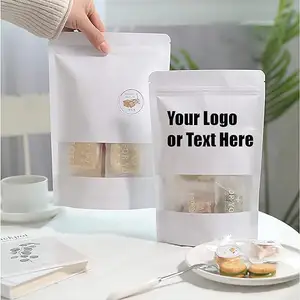Duyệt qua Alibaba.com để khám phá
Túi ziplock chất lượng tốt nhất cho phép người dùng đóng gói nhiều mặt hàng một cách đáng tin cậy và thuận tiện. Những chiếc túi chắc chắn và có khả năng tự dính này có nhiều biến thể khác nhau như túi loại bỏ và túi lâu dài, và chúng có khả năng chống mài mòn. Được trang bị khóa kéo kín khí, tất cả nội dung có thể được lưu trữ an toàn mà không bị rò rỉ. Được sản xuất bằng nhựa LDPE và PE chất lượng cao, chúng có thể mang các sản phẩm nặng một cách dễ dàng.
Túi có khóa zip bằng nhựa là sản phẩm hoàn hảo để đựng các vật dụng dạng lỏng.
Mua
túi khóa zip chịu lực cao để sử dụng trong gia đình hoặc thương mại. Từ đóng gói rau cắt nhỏ đến bánh mì, súp và mỹ phẩm, mặt hàng này thực sự linh hoạt và được sử dụng phổ biến trên toàn thế giới. Chúng được sản xuất bằng những nguyên liệu thô tốt nhất không độc hại, làm cho chúng hoàn toàn an toàn để bảo quản các món ăn được.
Túi có khóa kéo ziplock cũng có các tùy chọn phân hủy sinh học, làm cho chúng thân thiện với môi trường. Các sản phẩm này đã được kiểm tra, xác minh và chứng nhận để chứng minh các đặc tính có thể tái chế.
Alibaba.com cung cấp nhiều lựa chọn về
Túi ziplock với các hình dạng, kích thước, màu sắc, dung tích và chất lượng khác nhau. Từ túi giấy nhôm có thể tái sử dụng đến túi nhựa dùng một lần, người mua hàng có thể duyệt qua vô số lựa chọn để tìm ra sản phẩm phù hợp với nhu cầu của họ.
Túi ziplock có khóa kéo có một số thuộc tính mong muốn vì chúng chống ẩm, có kết cấu chống nước và có thể được sử dụng để đóng gói tất cả các loại mặt hàng.
Truy cập Alibaba.com để duyệt qua danh mục toàn diện để tìm
Túi ziplock thích hợp nhất cho nhu cầu cá nhân. Chúng đi kèm với các chứng nhận để đảm bảo chất lượng và tính xác thực.
Nhà cung cấp túi nhựa có khóa zip giảm giá tuyệt vời khi mua số lượng lớn. Nhanh tay và tận dụng những ưu đãi này ngay bây giờ.















